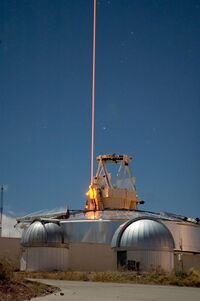Physics:Frequency addition source of optical radiation: Difference between revisions
imported>PolicyEnforcerIA (attribution) |
John Stpola (talk | contribs) (over-write) |
||
| Line 1: | Line 1: | ||
[[Image:Starfire Optical Range - sodium laser.jpg|thumb|200px|A 50W FASOR used at the [[ | {{Short description|Laser points of light in the sky for astronomical reference}} | ||
{{Other uses|FASOR (disambiguation)}} | |||
''' | [[Image:Starfire Optical Range - sodium laser.jpg|thumb|200px|A 50W FASOR used at the [[Starfire Optical Range]]]] | ||
'''Frequency addition source of optical radiation''' (acronym '''FASOR''') is used for a certain type of [[Physics:Laser guide star|guide star laser]] deployed at US Air Force Research Laboratory facilities [[Astronomy:Starfire Optical Range|SOR]] and AMOS. The laser light is produced in a [[Physics:Sum-frequency generation|sum-frequency generation]] process from two solid-state laser sources that operate at different wavelengths. The ''frequencies'' of the sources add directly to a summed frequency. Thus, if the source wavelengths are <math>\lambda_1</math> and <math>\lambda_2</math>, the resulting wavelength is | |||
:<math> \lambda = \left(\frac{1}{\lambda_1} + \frac{1}{\lambda_2} \right)^{-1}.</math> | :<math> \lambda = \left(\frac{1}{\lambda_1} + \frac{1}{\lambda_2} \right)^{-1}.</math> | ||
==Application== | ==Application== | ||
The FASOR | The FASOR was initially used for many [[Physics:Laser guide star|laser guide star]] experiments.<ref>Denman, C. A., Drummond, J. D., Eickhoff, M. L., Fugate, R. Q., Hillman, P. D., Novotny, S. J., & Telle, J. M. (2006, July). Characteristics of sodium guidestars created by the 50-watt FASOR and first closed-loop AO results at the Starfire Optical Range. In Advances in Adaptive Optics II (Vol. 6272, pp. 508-519). SPIE.</ref><ref>Drummond, J., Telle, J., Denman, C., Hillman, P., & Tuffli, A. (2004). Photometry of a sodium laser guide star at the Starfire Optical Range. Publications of the Astronomical Society of the Pacific, 116(817), 278.</ref> These have ranged from mapping the photon return verse wavelength, power, and pointing location in the sky. Two FASORS were used to show the advantages of 'back pumping' or pumping at both D2a and D2b lines.<ref>Denman, C., Moore, G., Drummond, J., Eickhoff, M., Hillman, P., Telle, J., ... & Fugate, R. (2006, November). Two-Frequency Sodium Guidestar Excitation at the Starfire Optical Range. In CFAO, Laser 2006 workshop.</ref> Later a FASOR was used to measure the Earth's magnetic field.<ref>Kane, T. J., Hillman, P. D., Denman, C. A., Hart, M., Phillip Scott, R., Purucker, M. E., & Potashnik, S. J. (2018). Laser remote magnetometry using mesospheric sodium. Journal of Geophysical Research: Space Physics, 123(8), 6171-6188.</ref> It has also been used for its intended application of generating a laser guidestar for adaptive optics, see first reference. It is tuned to the D2a hyperfine component of the [[Physics:Fraunhofer lines|sodium D line]] and used to excite [[Chemistry:Sodium|sodium]] atoms in the [[Earth:Sodium layer|mesospheric upper atmosphere]]. The FASOR consists of two single-frequency injection-locked Nd:YAG lasers close to 1064 and 1319 nm that are both resonant in a cavity containing a [[Chemistry:Lithium triborate|lithium triborate]] (LBO) crystal, which sums the frequencies yielding 589.159 nm light. | ||
==References== | |||
{{Reflist}} | |||
{{DEFAULTSORT:Frequency Addition Source Of Optical Radiation}} | {{DEFAULTSORT:Frequency Addition Source Of Optical Radiation}} | ||
[[Category:Laser science]] | [[Category:Laser science]] | ||
{{Sourceattribution|Frequency addition source of optical radiation}} | {{Sourceattribution|Frequency addition source of optical radiation}} | ||
Latest revision as of 17:26, 27 September 2025

Frequency addition source of optical radiation (acronym FASOR) is used for a certain type of guide star laser deployed at US Air Force Research Laboratory facilities SOR and AMOS. The laser light is produced in a sum-frequency generation process from two solid-state laser sources that operate at different wavelengths. The frequencies of the sources add directly to a summed frequency. Thus, if the source wavelengths are [math]\displaystyle{ \lambda_1 }[/math] and [math]\displaystyle{ \lambda_2 }[/math], the resulting wavelength is
- [math]\displaystyle{ \lambda = \left(\frac{1}{\lambda_1} + \frac{1}{\lambda_2} \right)^{-1}. }[/math]
Application
The FASOR was initially used for many laser guide star experiments.[1][2] These have ranged from mapping the photon return verse wavelength, power, and pointing location in the sky. Two FASORS were used to show the advantages of 'back pumping' or pumping at both D2a and D2b lines.[3] Later a FASOR was used to measure the Earth's magnetic field.[4] It has also been used for its intended application of generating a laser guidestar for adaptive optics, see first reference. It is tuned to the D2a hyperfine component of the sodium D line and used to excite sodium atoms in the mesospheric upper atmosphere. The FASOR consists of two single-frequency injection-locked Nd:YAG lasers close to 1064 and 1319 nm that are both resonant in a cavity containing a lithium triborate (LBO) crystal, which sums the frequencies yielding 589.159 nm light.
References
- ↑ Denman, C. A., Drummond, J. D., Eickhoff, M. L., Fugate, R. Q., Hillman, P. D., Novotny, S. J., & Telle, J. M. (2006, July). Characteristics of sodium guidestars created by the 50-watt FASOR and first closed-loop AO results at the Starfire Optical Range. In Advances in Adaptive Optics II (Vol. 6272, pp. 508-519). SPIE.
- ↑ Drummond, J., Telle, J., Denman, C., Hillman, P., & Tuffli, A. (2004). Photometry of a sodium laser guide star at the Starfire Optical Range. Publications of the Astronomical Society of the Pacific, 116(817), 278.
- ↑ Denman, C., Moore, G., Drummond, J., Eickhoff, M., Hillman, P., Telle, J., ... & Fugate, R. (2006, November). Two-Frequency Sodium Guidestar Excitation at the Starfire Optical Range. In CFAO, Laser 2006 workshop.
- ↑ Kane, T. J., Hillman, P. D., Denman, C. A., Hart, M., Phillip Scott, R., Purucker, M. E., & Potashnik, S. J. (2018). Laser remote magnetometry using mesospheric sodium. Journal of Geophysical Research: Space Physics, 123(8), 6171-6188.
 |

